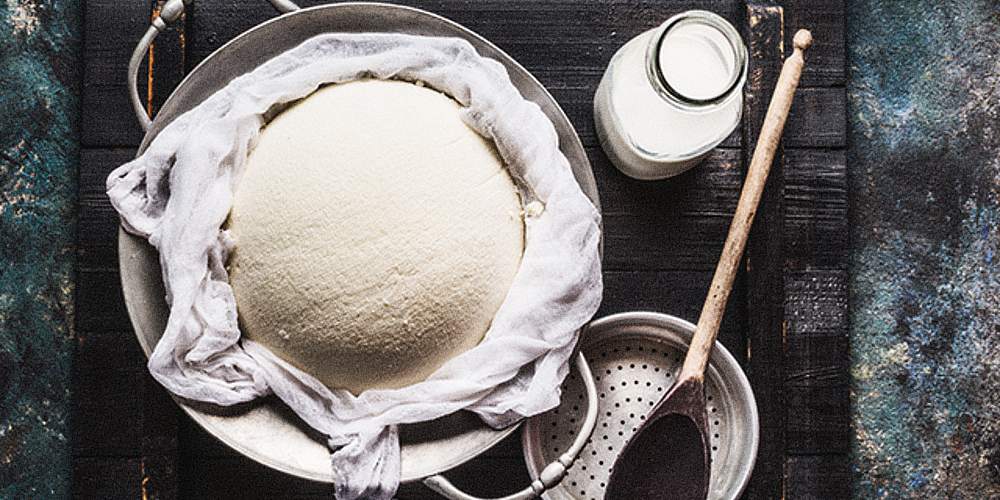- Cheese-making expert Adrienne Fiakas revealed a quick and easy technique to make creamy, stretchy mozzarella in just one hour using pre-acidified milk, making it accessible for both beginners and experienced cooks.
- The process relies on pre-acidifying milk overnight with freeze-dried culture, which not only enhances flavor and safety but also reduces the time needed for coagulation to just 30 minutes.
- Fiakas emphasized the importance of using rennet diluted in distilled water (not chlorinated) to evenly coagulate the milk into curds, ensuring the cheese achieves the ideal texture for stretching.
- The curds are heated in hot water (around 150°F) until pliable, then stretched and shaped into mozzarella balls, which are then brined to enhance flavor and preserve the cheese for up to a week.
- Fiakas and host Maryjory Wildcraft highlighted the benefits of homemade mozzarella, including superior freshness, control over ingredients and the rewarding experience of creating gourmet cheese at home with minimal equipment.
(Natural News)—During episode 8 of “Off Grid Survival Skills” by Marjory Wildcraft, aired Feb. 8 on Brighteon University, cheese-making expert Adrienne Fiakas has unveiled a surprisingly simple method to craft creamy, stretchy mozzarella in just 60 minutes. Fiakas shared her step-by-step guide to transforming fresh milk into restaurant-quality cheese right in your own kitchen. Whether you’re a seasoned homesteader or a curious foodie, this process is designed to demystify cheese-making and elevate your culinary skills.
The key to Fiakas’ one-hour mozzarella lies in pre-acidified milk, a technique that jumpstarts the cheese-making process. “What we’re doing here is acidifying the milk overnight,” Fiakas explained. “This ensures the cheese will taste good and be safe to eat.” By adding a small amount of freeze-dried culture to warm milk and letting it ferment, the milk’s pH changes, creating the perfect environment for coagulation. “The amount of culture isn’t as important,” she added. “Our goal is just to acidify the milk.”
This pre-culturing step not only enhances flavor but also significantly reduces the time needed to achieve the ideal texture. “If you don’t have pre-cultured milk, you’d need more time to acidify your milk,” Fiakas noted. “But with this method, we’re ready to go in 30 minutes.”
Once the milk is prepped, the next step involves rennet, a coagulant that transforms liquid milk into solid curds. Fiakas emphasized the importance of even distribution: “We dilute the rennet in water to ensure it’s evenly mixed into the milk.” She also warned against using chlorinated water, which can neutralize the rennet’s effectiveness. “Distilled water is your best bet,” she advised.
As the rennet works its magic, the milk begins to coagulate, forming delicate curds. “You’ll notice little flecks of protein forming,” Fiakas said. “This is called flocculation, and it’s a sign that the milk is turning into curds.” Once the curds are firm, they’re cut into cubes and gently heated to release whey, the liquid byproduct. “The goal is to have supple, moist curds that will stretch beautifully,” she explained.
The most satisfying part of the process is transforming the curds into smooth, stretchy mozzarella. Fiakas demonstrated how to heat the curds in hot water (around 150°F) until they become pliable. “You want to see the cheese stretch without breaking,” she said, shaping the molten curds into balls with practiced ease. “If it’s too hot, the cheese will lose moisture and become tough.”
The finished mozzarella is then plunged into an ice-cold brine to firm up and absorb salt. “This brine not only flavors the cheese but also preserves it,” Fiakas noted. “You can store the mozzarella in the brine for up to a week.”
Unparalleled freshness and flavor
For Wildcraft, who rarely consumes dairy, the homemade mozzarella was a revelation. “This stuff is fabulously delicious,” she exclaimed. “I’m making an exception here because it’s just that good.” Fiakas agreed, adding that the process is both rewarding and accessible. “With pre-cultured milk, this method is pretty foolproof,” she said. “Anyone can do it.”
Beyond the satisfaction of creating something from scratch, homemade mozzarella offers unparalleled freshness and flavor. “When you make it yourself, you control the quality of the milk and the ingredients,” Fiakas said. “It’s a way to connect with your food and appreciate the art of cheese-making.”
For those inspired to try their hand at this culinary craft, Fiakas’ method proves that gourmet cheese doesn’t require a professional kitchen—just a pot, some fresh milk and a little patience. As Wildcraft put it, “This is a game-changer for anyone who loves good food.” So, grab your apron and a gallon of milk—your journey from farm to table starts now.
If you want to learn more about the essential skills Wildcraft has gathered for you, purchase your copy of the “Off Grid Survival Skills” bundle here. You will get a copy of the videos from all 10 episodes, 29 life-saving video bonuses, 21 exclusive eBooks and and a physical copy of Wildcraft’s “The Grow Book System,” which will be delivered directly at your doorstep.
Sources include:



